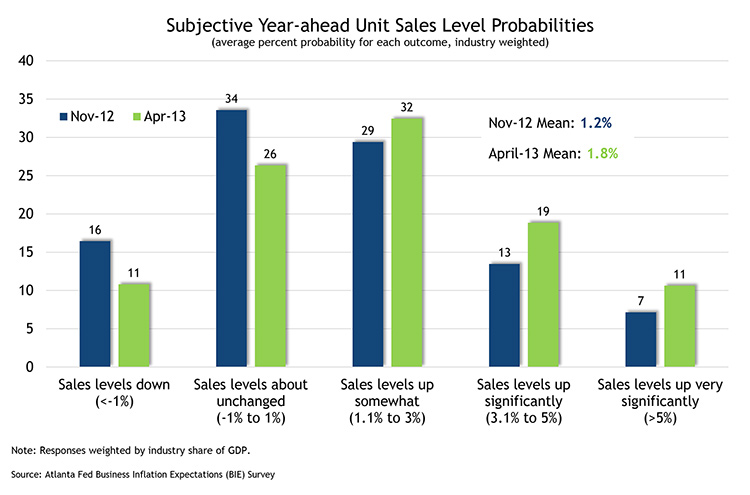Earlier this month, Dennis Lockhart, the Atlanta Fed’s top guy, gave his assessment of the economy and monetary policy to the Kiwanis Club of Birmingham, Alabama. Here’s the essential takeaway:
There are encouraging developments in the economy, to be sure, but the evidence of sustainable momentum that will deliver “substantial improvement in the outlook for the labor market” is not yet conclusive. ... How will I, as one policymaker, determine that the balance has shifted and the time for a policy change has come? Well, one key consideration is the array of risks to the economic outlook and my degree of confidence in the outlook.
To help the boss assess the risks to the outlook, we reached out to our Business Inflation Expectations (BIE) panel to get a sense of how they view the outlook for their businesses and, notably, how they assess the risks to that outlook. Specifically, we asked:
Projecting ahead, to the best of your ability, please assign a percent likelihood to the following changes to UNIT SALES LEVELS over the next 12 months.
The table below summarizes the answers and compares them to the responses we got to this statement last November.
First, the business outlook of our panel has improved decidedly since last November. On average, our panel sees unit sales growth averaging 1.8 percent. OK, not a spectacular number, but, to our eyes at least, much improved from the 1.2 percent the group was expecting when we queried five months ago.
And how about the assessment of the risks President Lockhart indicated was also a key consideration? Here again, the sentiment in our panel appears to have shifted favorably. Last November, our panel put the likelihood that their year-ahead unit sales growth would be 1 percent or less at 50 percent. The group now puts the chances of a downshift in business activity at 37 percent. Meanwhile, the upside potential for their sales has grown. Last November, the panel put the chances of a “significant” improvement in unit sales at about 20 percent; this month, the group thinks the likelihood is 30 percent.
And this improved sentiment isn’t centered in just a few industries—it’s spread across a wide swath of the economy. Firms in construction and real estate, which were, on average, projecting 12-month unit sales growth of 1.1 percent last November, now put that growth number at 1.8 percent. The average sales outlook of general-services firms has risen from 1 percent to 2.2 percent; finance and insurance companies went from 0.5 percent to 1.3 percent; and retailers/wholesalers’ unit sales projections rose from 1.5 percent to 2 percent. And manufacturers, who posted relatively strong expectations last November, reported about the same sales outlook this month as they did five months ago.
To be clear, President Lockhart’s recent comments—and the Federal Open Market Committee statement on which they are based—indicate he is looking for a substantial improvement in the outlook for the labor market, not sales. But we’re going to assume that it’s unlikely to have one without the having the other. And is our panel’s unit sales forecast “substantially” improved? Well, what constitutes “substantial” is in the eye of the beholder, but if this isn’t a substantial improvement in the outlook, it’s certainly a move in that direction.
 By Mike Bryan, vice president and senior economist, and
By Mike Bryan, vice president and senior economist, and
 Nick Parker, economic research analyst, both in the Atlanta Fed’s research department
Nick Parker, economic research analyst, both in the Atlanta Fed’s research department



